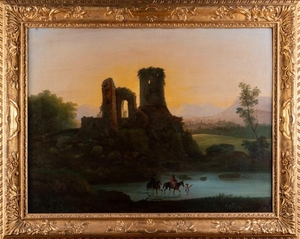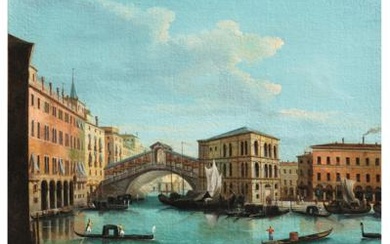GIUSEPPE BERNARDINO BISON River landscape with ruins
River landscape with ruins (flight to Egypt). . Oil on canvas . Cm 85,50 x 64,50. The artwork is accompanied by a card by Fabrizio Magani. The painting in question, which records with originality the emotional vibrations of the great theatre of nature, also leads to represent the call of the place and the atmospheric light towards artists ninenteenth century, attracted by the variable physiognomy of such landscapes and endowed with that ineffable filter of the eyes such as to possess in the memory the profound truth of the physiognomy of the mountain, of the water and of the sky. The interweaving of stylistic data allows in addition to determine the personality of the painter, certainly sure of his own means and his limpid vocation, that is the way of Giuseppe Bernardo Bison, raised artistically in Venice, become one of the leading figures in the lively atmosphere of Trieste and open to explore the opportunities of a capital such as Milan, when in 1831 he chose to reside there untile 1844, encountering death. The vision of the river seems to instantly capture the eye of the artist, who knows how to develop the tools for the definition of the locus amoenus and, almost to rehabilitate the tried and tested classic tradition - literary of the eighteenth century Arcadia, qualifies its peculiarities as a sort of refuge where travelers seem to spend good hours, if it were not the episode of the Holy Family during the flight to Egypt to unmask the possible subject of the painting, hidden in clear horizons. The teacher resolves the contrast between direct study of places and imaginative faculty, accompanies the observer to an immediate adherence to the fleeting essence of nature and therefore to the commitment to witness in its most authentic expression. A quiet diffused nitor, which tends to crystallize the effects of light, reaches the complete focus of spaces dilated and controlled by the wise direction of composition. This is a work of absolute finesse dating back to the last period of the artist of Friuli origin. In the present painting the master at the end of his career knows how to wisely reaffir, the vocation towards compositional virtuosity and the transparency of colour changes. Even the technique employed seems to allude to Bison's predilections in the last years of his career. It is just the case to say that the artist "thickens" the delicate state of suspension in merging the water with the sky, and more generally all the components of that particular universe. The mountains form the backdrop to a very popular vision, almost captured by reality, and here particularly linked to the culture of the Venetian lanscape of the eighteenth century, with a more open adhesion to the ways of Marco Ricci and Giuseppe Zais. The master, as shown by the many gender drawings, was attracted by the minor portagonists of street life, such as farmers, fishermen, the wayferers and shepherds whom he recognizes in their expressive autonomy in picturesque annotations and which returns to the quiet archaic dimension in the subsequent landscape elaboration. The sharpness of the character of the street characters is reached by the essentiality of the touch, but also by the quick synthesis of the sign, as also shown by the many drawings in which the use of ink stain prevails accompanied by the free improvisation of pencil marks, characteristics that show an incomparable and interrupted vitality. Like genre paintings of obvious Flemish origin, the work under consideration clearly identifies the roots of inspiration and the direct references to a theme of costume, which leads the artist to face "philanderal" repertoiresin the evidence given, for example, to the showy headdress of the seventeenth century knight. Certainly the master has adhered, in proposing the work, to the notion of taste "troubadour", according to which the analytical combination of the elements characterizing the fashion of the past, at the beginning inspired by the imaginary three - fifteenth century, it approaches in time to sentimental tones more generally romance. It is, as is well known, one of the many declinations of contemporary romantica sensibility, in whose bed is fully entitled, for reasons of taste and style, also the work presented here. . Frame present
[ translate ]View it on
Sale price
Estimate
Time, Location
Auction House
River landscape with ruins (flight to Egypt). . Oil on canvas . Cm 85,50 x 64,50. The artwork is accompanied by a card by Fabrizio Magani. The painting in question, which records with originality the emotional vibrations of the great theatre of nature, also leads to represent the call of the place and the atmospheric light towards artists ninenteenth century, attracted by the variable physiognomy of such landscapes and endowed with that ineffable filter of the eyes such as to possess in the memory the profound truth of the physiognomy of the mountain, of the water and of the sky. The interweaving of stylistic data allows in addition to determine the personality of the painter, certainly sure of his own means and his limpid vocation, that is the way of Giuseppe Bernardo Bison, raised artistically in Venice, become one of the leading figures in the lively atmosphere of Trieste and open to explore the opportunities of a capital such as Milan, when in 1831 he chose to reside there untile 1844, encountering death. The vision of the river seems to instantly capture the eye of the artist, who knows how to develop the tools for the definition of the locus amoenus and, almost to rehabilitate the tried and tested classic tradition - literary of the eighteenth century Arcadia, qualifies its peculiarities as a sort of refuge where travelers seem to spend good hours, if it were not the episode of the Holy Family during the flight to Egypt to unmask the possible subject of the painting, hidden in clear horizons. The teacher resolves the contrast between direct study of places and imaginative faculty, accompanies the observer to an immediate adherence to the fleeting essence of nature and therefore to the commitment to witness in its most authentic expression. A quiet diffused nitor, which tends to crystallize the effects of light, reaches the complete focus of spaces dilated and controlled by the wise direction of composition. This is a work of absolute finesse dating back to the last period of the artist of Friuli origin. In the present painting the master at the end of his career knows how to wisely reaffir, the vocation towards compositional virtuosity and the transparency of colour changes. Even the technique employed seems to allude to Bison's predilections in the last years of his career. It is just the case to say that the artist "thickens" the delicate state of suspension in merging the water with the sky, and more generally all the components of that particular universe. The mountains form the backdrop to a very popular vision, almost captured by reality, and here particularly linked to the culture of the Venetian lanscape of the eighteenth century, with a more open adhesion to the ways of Marco Ricci and Giuseppe Zais. The master, as shown by the many gender drawings, was attracted by the minor portagonists of street life, such as farmers, fishermen, the wayferers and shepherds whom he recognizes in their expressive autonomy in picturesque annotations and which returns to the quiet archaic dimension in the subsequent landscape elaboration. The sharpness of the character of the street characters is reached by the essentiality of the touch, but also by the quick synthesis of the sign, as also shown by the many drawings in which the use of ink stain prevails accompanied by the free improvisation of pencil marks, characteristics that show an incomparable and interrupted vitality. Like genre paintings of obvious Flemish origin, the work under consideration clearly identifies the roots of inspiration and the direct references to a theme of costume, which leads the artist to face "philanderal" repertoiresin the evidence given, for example, to the showy headdress of the seventeenth century knight. Certainly the master has adhered, in proposing the work, to the notion of taste "troubadour", according to which the analytical combination of the elements characterizing the fashion of the past, at the beginning inspired by the imaginary three - fifteenth century, it approaches in time to sentimental tones more generally romance. It is, as is well known, one of the many declinations of contemporary romantica sensibility, in whose bed is fully entitled, for reasons of taste and style, also the work presented here. . Frame present
[ translate ]



